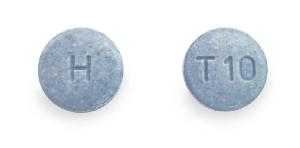Tolvaptan Dosage
Medically reviewed by Drugs.com. Last updated on Dec 12, 2023.
Applies to the following strengths: 15 mg; 30 mg; 45 mg-15 mg; 60 mg-30 mg; 90 mg-30 mg; 30 mg-15 mg
Usual Adult Dose for:
Additional dosage information:
Usual Adult Dose for Hyponatremia
Initial dose: 15 mg orally once a day
Maintenance dose: Increase the dose to 30 mg once a day, after at least 24 hours, to a maximum of 60 mg once a day, as needed to achieve the desired level of serum sodium.
Maximum dose: 60 mg once a day
Duration of therapy: Maximum of 30 days
Comments:
- During initiation and titration, frequently monitor for changes in serum electrolytes and volume.
- Avoid fluid restriction during the first 24 hours of therapy.
- Patients receiving tolvaptan should be advised that they can continue ingestion of fluid in response to thirst.
- Tolvaptan may be dosed without regard to meals.
Uses: Hypervolemic and euvolemic hyponatremia [serum sodium less than 125 mEq/L or less marked hyponatremia that is symptomatic and has resisted correction with fluid restriction], including patients with heart failure, and Syndrome of Inappropriate Antidiuretic Hormone (SIADH)
Usual Adult Dose for Hyponatremia, euvolemic
Initial dose: 15 mg orally once a day
Maintenance dose: Increase the dose to 30 mg once a day, after at least 24 hours, to a maximum of 60 mg once a day, as needed to achieve the desired level of serum sodium.
Maximum dose: 60 mg once a day
Duration of therapy: Maximum of 30 days
Comments:
- During initiation and titration, frequently monitor for changes in serum electrolytes and volume.
- Avoid fluid restriction during the first 24 hours of therapy.
- Patients receiving tolvaptan should be advised that they can continue ingestion of fluid in response to thirst.
- Tolvaptan may be dosed without regard to meals.
Uses: Hypervolemic and euvolemic hyponatremia [serum sodium less than 125 mEq/L or less marked hyponatremia that is symptomatic and has resisted correction with fluid restriction], including patients with heart failure, and Syndrome of Inappropriate Antidiuretic Hormone (SIADH)
Renal Dose Adjustments
Mild to moderate renal dysfunction (CrCl 10 to 79 mL/min): No adjustment recommended.
Severe renal dysfunction (CrCl less than 10 mL/min): Not recommended for use.
Liver Dose Adjustments
Moderate and severe hepatic impairment do not affect exposure to tolvaptan to a clinically relevant extent. No dose adjustment of tolvaptan is necessary.
Precautions
The US FDA requires a Risk Evaluation and Mitigation Strategy (REMS) for this drug. It includes a communication plan, elements to assure safe use, and an implementation system. For additional information: www.accessdata.fda.gov/scripts/cder/rems/index.cfm
CONTRAINDICATIONS:
- Hypersensitivity to this drug or to any of its components
- Anuria
- Hypovolemic hyponatremia
- Patients unable to perceive or respond to thirst
- Concomitant use of strong CYP450 3A inhibitors
- Autosomal Dominant Polycystic Kidney Disease (ADPKD) outside of FDA-approved REMS
US BOXED WARNINGS:
- INITIATING THERAPY AND MONITORING SODIUM: This drug should be initiated and reinitiated only in a hospital setting where serum sodium can be monitored closely. Rapid correction of hyponatremia (e.g., greater than 12 mEq/L/24 hrs) can cause osmotic demyelination resulting in dysarthria, mutism, dysphagia, lethargy, affective changes, spastic quadriparesis, seizures, coma, and death.
- AUTOSOMAL DOMINANT POLYCYSTIC KIDNEY DISEASE (ADPKD): Due to risk of hepatotoxicity, this drug should not be used for ADPKD outside of the FDA-approved REMS.
Safety and efficacy have not been established in patients younger than 18 years.
Consult WARNINGS section for additional precautions.
Dialysis
Data not available
Other Comments
Administration advice:
- This drug can be taken without regard to meals.
Storage requirements:
- Store at 25C (77F)
- Keep out of the reach of children.
General:
- Grapefruit juice should be avoided during treatment with this drug.
- Following discontinuation, patients should be advised to resume fluid restriction and should be monitored for changes in serum sodium and volume status.
Patient advice:
- Female patients should inform their healthcare provider of a known or suspected pregnancy.
Frequently asked questions
More about tolvaptan
- Check interactions
- Compare alternatives
- Pricing & coupons
- Drug images
- Side effects
- During pregnancy
- Drug class: vasopressin antagonists
- En español
Patient resources
Other brands
Professional resources
Other brands
Related treatment guides
See also:
Further information
Always consult your healthcare provider to ensure the information displayed on this page applies to your personal circumstances.


